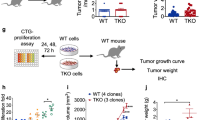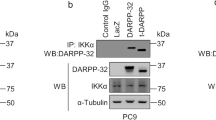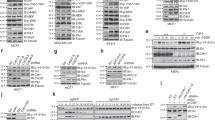Abstract
DAP kinase is a new type of calcium/calmodulin-dependent enzyme that phosphorylates serine/threonine residues on proteins. Its structure contains ankyrin repeats and the ‘death’ domain, and it is associated with the cell cytoskeleton1,2,3. The gene encoding DAP kinase was initially isolated as a positive mediator of apoptosis induced by interferon-γ, by using a strategy of functional cloning4. We have now tested whether this gene has tumour-suppressive activity. We found that lung carcinoma clones, characterized by their highly aggressive metastatic behaviour and originating from two independent murine lung tumours, did not express DAP kinase, in contrast to their low-metastatic counterparts. Restoration of DAP kinase to physiological levels in high-metastatic Lewis carcinoma cells suppressed their ability to form lung metastases after intravenous injection into syngeneic mice, and delayed local tumour growth in a foreign ‘microenvironment’. Conversely, in vivo selection of rare lung lesions following injection into syngeneic mice of low-metastatic Lewis carcinoma cells or of DAP kinase transfectants, was associated with loss of DAP kinase expression. In situ TUNEL staining of tumour sections revealed that DAP kinase expression from the transgene raised the incidence of apoptosis in vivo. DAP-kinase transfectants also showed increased sensitivity in vitro to apoptotic stimuli, of the sort encountered by metastasizing cells at different stages of malignancy. We propose that loss of DAP kinase expression provides a unique mechanism that links suppression of apoptosis to metastasis.
This is a preview of subscription content, access via your institution
Access options
Subscribe to this journal
Receive 51 print issues and online access
$199.00 per year
only $3.90 per issue
Buy this article
- Purchase on Springer Link
- Instant access to full article PDF
Prices may be subject to local taxes which are calculated during checkout




Similar content being viewed by others
References
Deiss, L. P., Feinstein, E., Berissi, H., Cohen, O. & Kimchi, A. Identification of a novel serine/threonine kinase and a novel 15-kD protein as potential mediators of the gamma interferon-induced cell death. Genes Dev. 9, 15–30 (1995).
Cohen, O., Feinstein, E. & Kimchi, A. DAP-kinase is a Ca2+/calmodulin-dependent, cytoskeletal-associated protein kinase, with cell death-inducing functions that depend on its catalytic activity. EMBO J. 16, 998–1008 (1997).
Feinstain, E., Wallach, D., Boldin, M., Varfolomeev, E. & Kimchi, A. The death domain: a module shared by proteins with diverse cellular functions. Trends Biochem. Sci. 20, 342–344 (1995).
Deiss, L. P. & Kimchi, A. Agenetic tool used to identify thioredoxin as a mediator of a growth inhibitory signal. Science 252, 117–120 (1991).
Clarke, A. R. et al. Thymocyte apoptosis induced by p53-dependent and independent pathways. Nature 362, 849–852 (1993).
Lowe, S. W., Schmitt, E. M., Smith, S. W., Osborne, B. A. & Jacks, T. p53 is required for radiation-induced apoptosis in mouse thymocytes. Nature 362, 847–849 (1993).
Haffner, R. & Oren, M. Biochemical properties and biological effects of p53. Curr. Opin. Genet. Dev. 5, 84–90 (1995).
Graeber, T. G. et al. Hypoxia-mediated selection of cells with diminished apoptotic potential in solid tumors. Nature 379, 88–91 (1996).
Morin, P. J., Vogenstein, B. & Kinzler, K. W. Apoptosis and APC in colorectal tumorigenesis. Proc. Natl Acad. Sci. USA 93, 7950–7954 (1996).
Bakhshi, A. et al. Cloning the chromosomal breakpoint of t(14;18) human lymphomas: clustering around JH on chromosome 14 and near a transcriptional unit on 18. Cell 41, 899–906 (1985).
Tsujimoto, Y. et al. Clustering of breakpoints on chromosome 11 in human B-cell neoplasms with the t(11;14) chromosome translocation. Nature 315, 340–343 (1985).
Reed, J. C. Regulation of apoptosis by bcl-2 family proteins and its role in cancer and chemoresistance. Curr. Opin. Oncol. 7, 541–546 (1995).
Naik, P., Karrim, J. & Hanahan, D. The rise and fall of apoptosis during multistage tumorigenesis: down-modulation contributes to tumor progression from angiogenic progenitors. Genes Dev. 10, 2105–2116 (1996).
Kissil, J. L. et al. DAP-kinase loss of expression in B-cell leukemia and bladder carcinoma cell lines: possible implications for role as tumor suppressor gene. Oncogene 15, 403–407 (1997).
Eisenbach, L., Segal, S. & Feldman, M. MHC imbalance and metastatic spread in Lewis lung carcinoma clones. Int. J. Cancer 32, 113–120 (1983).
Layton, M. G. & Franks, L. M. Heterogeneity in a spontaneous mouse lung carcinoma: selection and characterization of stable metastatic variants. Br. J. Cancer 49, 415–421 (1984).
Laird, P. W. Oncogenic mechanisms mediated by DNA methylation. Mol. Med. Today 3, 223–229 (1997).
Bursch, W., Paffe, S., Putz, B., Barthel, G. & Schulte-Hermann, R. Determination of the length of the histological stages of apoptosis in normal liver and in altered hepatic foci of rats. Carcinogenesis 11, 847–853 (1990).
Meredith, J. E. J, Fazeli, B. & Schwartz, M. A. The extracellular matrix as a well survival factor. Mol. Biol. Cell 4, 953–961 (1993).
Meredith, J. E. J & Schwartz, M. A. Integrins, adhesion and apoptosis. Trends Cell Biol. 7, 146–150 (1997).
Frisch, S. M. & Francis, H. Disruption of epithelial cell-matrix interactions induces apoptosis. J. Cell Biol. 124, 619–626 (1994).
Boudreau, N., Sympson, C. J., Werb, Z. & Bissell, M. J. Suppression of ICE and apoptosis in mammary epithelial cells by extracellular matrix. Science 267, 891–893 (1995).
Plaksin, S., Gelber, C., Feldman, M. & Eisenbach, L. Reversal of the metastatic phenotype in Lewis lung carcinoma cells after transfection with syngeneic H-2Kb gene. Proc. Natl Acad. Sci. USA 85, 4463–4467 (1988).
Holmgren, L., O'Reilly, M. S. & Folkman, J. Dormancy of micrometastases: balanced proliferation and apoptosis in the presence of angiogenesis suppression. Nature Med. 1, 149–153 (1995).
Nikiforov, M. A. et al. p53 modulation of anchorage independent growth and experimental metastasis. Oncogene 13, 1710–1720 (1996).
Shtivelman, E. Alink betwen metastasis and resistance to apoptosis of variant small-cell lung carcinoma. Oncogene 14, 2167–2173 (1997).
Fidler, I. J. & Balch, C. M. The biology of cancer metastasis and implications for therapy. Curr. Prob. Surg. 24, 129–209 (1987).
Weiss, L. Biochemical interactions of cancer cells with the microvasculature during hematogenous metastatis. Cancer Metastasis Rev. 11, 227–235 (1992).
Xie, K. P., Dong, Z. Y. & Fidler, I. J. Activation of nitric oxide synthase gene for inhibition of cancer metastasis. J. Leuk. Biol. 59, 797–803 (1996).
Yamauchi, A., Taga, K., Mostowski, H. S. & Bloom, E. T. Target cell-induced apoptosis of interleukin-2-activated human natural killer cells: roles of cell surface molecules and intracellular events. Blood 87, 5127–5135 (1996).
Acknowledgements
We thank E. Feinstein for discussions and for comments on the manuscript, J.L.Kissil, S. Ben-Bassat, D. Popovic and H. El-Shami for technical assistance, and L. M. Franks for the CMT-64 clones. The work was supported by QBI Ltd and by a grant from the Israeli Ministry of Science. A.K. is an Incumbent of the Helena Rubinstein Chair of Cancer Research. L.E. is an Incumbent of the G.F. Duckwitz Chair of Cancer Research.
Author information
Authors and Affiliations
Corresponding author
Rights and permissions
About this article
Cite this article
Inbal, B., Cohen, O., Polak-Charcon, S. et al. DAP kinase links the control of apoptosis to metastasis. Nature 390, 180–184 (1997). https://doi.org/10.1038/36599
Received:
Accepted:
Issue Date:
DOI: https://doi.org/10.1038/36599
This article is cited by
-
Death-associated protein kinase 1 phosphorylates MDM2 and inhibits its protein stability and function
Archives of Pharmacal Research (2023)
-
Cell Death Pathways in Ischemic Stroke and Targeted Pharmacotherapy
Translational Stroke Research (2020)
-
miR-483-5p decreases the radiosensitivity of nasopharyngeal carcinoma cells by targeting DAPK1
Laboratory Investigation (2019)
-
DAPK1 loss triggers tumor invasion in colorectal tumor cells
Cell Death & Disease (2019)
-
p14ARF interacts with the focal adhesion kinase and protects cells from anoikis
Oncogene (2017)
Comments
By submitting a comment you agree to abide by our Terms and Community Guidelines. If you find something abusive or that does not comply with our terms or guidelines please flag it as inappropriate.



